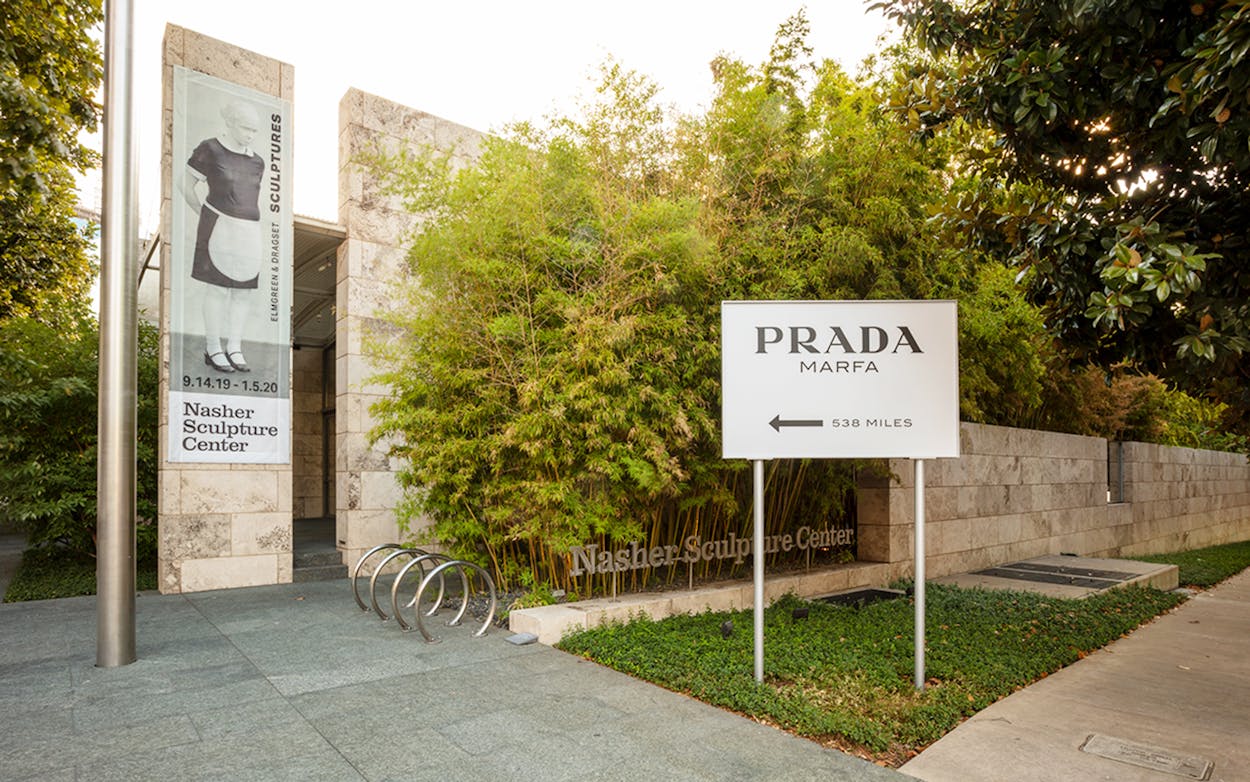The artistic duo Elmgreen & Dragset have stood an ear-shaped swimming pool on its side at Rockefeller Center, blocked an excellent view of the Statue of Liberty with an oversized, unusable telescope, and turned galleries into bathhouses. But their best-known work is located in Texas.
One of the art world’s premier selfie destinations, Prada Marfa is so well-known that even Beyoncé couldn’t resist a photo opportunity. Built in a desolate part of West Texas, in Valentine, the isolated faux luxury store has made appearances on episodes of The Simpsons and Gossip Girl. At first, Michael Elmgreen and Ingar Dragset figured their fake Prada shop would be something people in passing cars would occasionally wonder about. When they debuted the sculpture in 2005, back before Marfa was a popular destination with luxury hotels, they did so while sipping homemade tequila and listening to country music with a crowd of about thirty people, mostly local ranchers.
The permanent installation was vandalized and looted within a couple days, and TxDOT initially viewed it as a billboard that would require permits. Amazed that many now make trips for the sole purpose of viewing their work, the duo recently revisited Prada Marfa for the first time since it was completed. That’s not the only thing bringing the Scandinavian duo to Texas. This month, they were back in the Lone Star State with their first major museum exhibition in the United States, at Dallas’s Nasher Sculpture Center.
On view until January 5, Elmgreen & Dragset: Sculptures consciously disrupts any notion of a museum setting—it’s fitting for an institution known for challenging perceptions of sculpture. It’s also similar to their past work in that the art isn’t just confined to the galleries. A billboard for Prada Marfa sits outside, while one sculpture greets you in the foyer. The two pairs of underwear and blue jeans scattered under the stairs are part of the exhibit and not, in fact, evidence of a rather bold display of public affection. The cooler nestled in the sculpture garden brings picnics to mind, but it’s actually a bronze sculpture. The donation box in the lobby containing randomly discarded items, not unlike a trashcan? That’s also part of the show.


“We like to put artworks in areas of the institution where you normally wouldn’t have an artwork,” Dragset says. “And we also like artworks that don’t look like artworks, because there is more opportunity to reflect on it beyond whether or not it is good.”
In conjunction with the main exhibit, the the artists curated sculptural selections from the Nasher’s permanent collection, including their own untitled marble sculpture inspired by René Magritte’s painting The Lovers. For their take on the Surrealist masterpiece, they created a three-dimensional version of the famous kissing couple separated by fabric. Elmgreen & Dragset also added an audio component to the companion show that makes it feel as though the sculptures in it are talking amongst themselves. “Why are we here on display?” one sculpture asks. “Just enjoy it while it lasts,” another responds, before another gets their attention with moaning sounds. Along with their sculptures, the artists also put together a performance art piece that involves three people sitting at desks in one of the galleries. They’re creating entries for an ongoing “Dallas Diaries” series, which adds a sense of intimacy to the exhibit.
Elmgreen & Dragset have been employing sculpture, performance, and architecture in their work since 1995. With backgrounds in poetry and theater, they were perplexed by the art world and frequently subvert it with complex public installations that are often temporary, not for sale, or not immediately recognizable as art—something they exemplified both with Prada Marfa and with their fictional art fair in Beijing in 2016.
“We were allowed to do silly experiments and form ourselves at our own pace,” says Elmgreen. “I worry about some of the younger artists now. I think there is far too much pressure on them today. The art education is pricey and from the galleries there is often too much demand on the artists to deliver to all these art fairs and special events before they are ready for that kind of exposure.”


“There are also rules around art institutions that are kind of terrifying and unwritten rules that make you behave in a certain way,” adds Dragset. “So our first artworks very much tested the limits of art institutions.”
Their latest sculptures embody a similar ethos. One motif, the looming vulture that symbolizes art critics, makes two appearances in the Nasher show: the first is perched on a mirrored lifeguard bench, and another is sitting on a branch of a tree sculpture. “Traces of a Never Existing History/Powerless Structures, Fig. 222,” a work from 2001, has been recreated for this show. Located in the sculpture garden, the enormous installation appears to be a life-size contemporary art gallery that’s sinking into the earth, with “Temporary Art” being the only words still visible on the front of the building.
For Elmgreen and Dragset, trickery, humor, and absurdity serve as a buffer to make serious works more engaging and less confrontational. The Nasher’s survey of their work recreates many of their old pieces, in what Elmgreen says “shows the wide range of approaches to sculpture that we have been testing out.”
The new exhibit’s most controversial piece is also its most striking. It’s a life-size sculpture of a boy looking up at a rifle mounted on the wall. By starting a conversation about gun control in an era of mass shootings, Elmgreen & Dragset want viewers to consider how the boy’s life will be affected by the firearm. “These horrible mass shootings are not only a gun problem, but a problem of masculinity,” Elmgreen says. “All of these shootings are done by men. There is something about that masculine approach to firearms that we need to discuss.”






